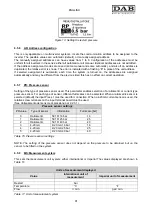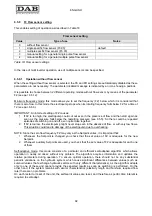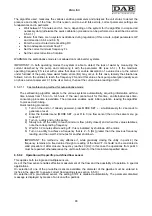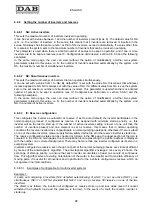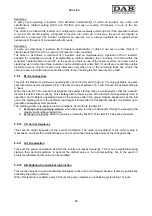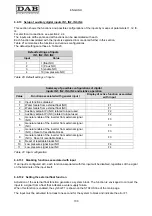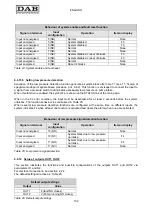
ENGLISH
98
6.6.8
Setting the number of inverters and reserves
6.6.8.1
NA: Active inverters
This sets the maximum number of inverters involved in pumping.
It can be set with a value between 1 and the number of inverters present (max. 8). The default value for NA
is N, i.e. the number of inverters in the series; this means that if inverters are removed or inserted in the
series, NA always has the same number as that of the inverters, as read automatically. If a value other than
N is entered, the system sets to the maximum number of inverters that can be involved in pumping.
This parameter is used when there is a limited number of pumps to be kept in operation, and if one or more
inverters are to be kept as reserves (see IC: Configurazione della riserva section 6.6.8.3 and the following
examples).
In the same menu page, the user can view (without the option of modification) a further two system
parameters related to this value, i.e. N, the number of inverters detected automatically by the system, and
NC, the maximum number of simultaneous inverters.
6.6.8.2
NC: Simultaneous inverters
This sets the maximum number of inverters that can operate simultaneously.
It can be set with a value from 1 to NA. By default NC is set with the value NA; this means that whatever
increase applied to NA, NC is always set with the value of NA. If a different value from NA is set, the system
sets to the set maximum number of simultaneous inverters. This parameter is used when there is a limited
number of pumps to be kept in operation (see IC: Configurazione della riserva section 6.6.8.3 and the
following examples).
In the same menu page, the user can view (without the option of modification) a further two system
parameters related to this value, i.e. N, the number of inverters detected automatically by the system, and
NA, the number of active inverters.
6.6.8.3
IC: Reserve configuration
This configures the inverter as automatic or reserve. If set to auto (default) the inverter participates in the
normal pumping process; if configured as reserve, it is assigned with minimum start-up priority, i.e. this
inverter will be the last to start up. If the number of active inverters setting is lower of one unit than the
number of inverters present and one element is set as reserve, this means that in normal operating
conditions the reserve inverter does not participate in normal pumping operations; otherwise if there is a fault
on one of the active inverters, (power supply failure, safety device trip etc.) the reserve inverter is started up.
The reserve configuration status can be checked as follows: in the SM page, the upper section of the icon is
coloured; in the AD and main pages, the communication icon representing the inverter address is displayed
with the number on a coloured background. There may be more than one inverter configured as reserve in a
pumping system.
Inverters configured as reserve, even though not part of the normal pumping process, are still kept efficient
by means of the anti-stagnant algorithm. The anti-stagnant algorithm envisages, once every 23 hours, the
exchange of start-up priority, to ensure that each inverter accumulates at least one minute of continuous
flow. This algorithm aims at avoiding deterioration of the water in the impeller and to maintain efficiency of
moving parts; it is useful for all inverters and in particular for the inverters configured as reserve, which do
not operate in normal conditions.
6.6.8.3.1 Examples
of
configuration for multi-inverter systems
Example 1:
A pump set comprising 2 inverters (N=2 detected automatically) of which 1 is set as active (NA=1), one
simultaneous (NC=1 or NC=NA provided that NA=1) and one as reserve (IC=reserve on one of the two
inverters).
The effect is as follows: the inverter not configured as reserve starts up and runs alone (even if it cannot
withstand the hydraulic load and the pressure is too low). In the event of a fault, the reserve inverter is
started up.
Summary of Contents for MCE-22/P
Page 278: ...274 1 276 2 279 3 280 4 282 5 283 6 4 20 284 7 285 8 286 9 287 10 290 11 290 12 292...
Page 279: ...275 IEC 60634...
Page 280: ...276 1 6 MCE 22 P MCE 15 P MCE 11 P 1 1 1...
Page 282: ...278 2 5 2 1 2 1 2 2 1 1 2 1 2 L L L 2 2 4 15...
Page 283: ...279 2 2 2 1 2 2 1 1 3 1 LN 2 2 3 1 3 4 4...
Page 284: ...280 A 3 3 2 2 1 2 4 3 1 UVW 2 2 4 3 50 60 200 1...
Page 286: ...282 4 2 2 3 Press e Flow 5 A B C D d1 d2...
Page 291: ...287 3 9 64 X 128 4 MODE SET 9 7 MODE 1 SET 8 3 EEprom SET 6 SET MODE...
Page 292: ...288 3 1 9 3 2 1 2 3 2 1 MODE SET MODE 8 2 2 5 5 5 2 2 9...
Page 294: ...290 3 2 2 10 SET 10 15 12 11...
Page 296: ...292 12 12 12 GO SB...
Page 297: ...293 4 4 1 Link 8 4 2 4 2 1 Link 2 Link 5...
Page 300: ...296 4 3 1 2 1 4 3 1 3 SET MODE LA RC FN MS FS FL AC AE O1 1 O2 2 4 4 ET 6 6 9 FL...
Page 326: ...322 BL 10 6 24 24 30 LP 180 200 HP OT TE 100 C 85 C OB BT 120 C 100 C OC 10 6 OF 10 6 30...
Page 327: ...323 8 8 1 PMW 4 2 8 2 8 3 8 3 SET EE EEprom FLASH...
Page 494: ...490 1 492 2 495 3 496 4 498 5 499 6 4 20 mA 500 7 501 8 502 9 503 10 506 11 506 12 508 13 523...
Page 495: ...491 IEC 364 inverter...
Page 496: ...492 1 Inverter inverter inverter 6 inverter MCE 22 P MCE 15 P MCE 11 P 1 1 1...
Page 499: ...495 2 2 2 1 inverter inverter 2 2 1 1 inverter 3 1 LN 2 inverter 2 PVC 3 inverter 1 3 inverter...
Page 502: ...498 4 2 2 3 Press Flow 5 A B C D d1 d2...
Page 507: ...503 3 9 oled 64 X 128 4 MODE SET 9 inverter 7 MODE 1 SET 8 3 EEprom SET 6 SET MODE...
Page 508: ...504 3 1 9 3 2 1 2 3 2 1 MODE SET Setpoint MODE 9 ONOMA TOY MENOY 2 Setpoint 2 5 5 5 2 2 9...
Page 512: ...508 12 12 12 GO SB FAULT...
Page 543: ...539 8 8 1 PMW 4 2 8 2 inverter 8 3 8 3 inverter SET EEPROM FLASH setpoint...
Page 599: ...595...








